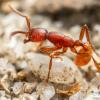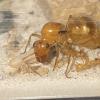and if you don’t mind me asking.. how did you go about acquiring the evidence labeled (a), (One only needs a single specimen to designate a novel species such as M.heureka above. Since there can be diverse morphology between queens and workers (both female we won't discuss males) if let's say one only had a single queen specimen one felt was a novel species candidate. It would be easy to most likely get it down to subfamily then genus. To species level one would need, ideally, confirmed specimens of queens or very throughly written detailed descriptions of queens in that genus to begin comparing and "cross referencing".Or where you saying I would need a initial specimen of a known Pogonomyrmex sp. to cross reference with the same caste of the species being described, and submitting any caste for the holotype in the species is acceptable? Ex. I could submit a holotype that is a male of a specific new Pogonomyrmex sp. as long as when describing it, its differences are cross referenced with a known Pogonomyrmex sp.?
The M heureka example is rather extreme since the initial worker found was so unlike any previously described ant from that region that "red flags" were raised. If one had a single worker of a putative Pognomyrmex "X" ant then designating it a novel species would be much more demanding and reviewers and experts in that genus would expect very definitive evidence to accept the claim of "species novum" was worthy. This is what I had to demonstrate when I had found what I was certain was a novel species of Tapinoma from Tennessee and it took time to lay out various forms of evidence: (a) nuclear DNA, (b.) mitochondrial DNA, (c.) unique and distinct morphology, (d) behavior and (e) allochrony and (f) oligogyny colony structure. Thus 7 lines of evidence. Had I found this ant in a rain forest less demanding evidence may have been accepted, but since I found a putative new species in an area where new ants that are not cryptic are rarely or ever found anymore (unless it is a genus level reassessment which these days is almost always based a suit of nuclear genes) and in a genus that has only a limited number of endemic species the bar of "burden of proof"was substantially raised.
Sent from my iPhone using Tapatalk






 thermal cycler (BioRad, Hercules, California) using the following conditions: 95°C for 10 min, 4 cycles of 94°C for 1 min, 45°C for 1.5 min, 72°C for 1.5 min; 34 cycles of 94°C for 1 min, 45°C for 1.5 min, 72°C for 1 min; and a final extension of 72°C for 3 min. The 638-bp products were visualized using a 0.9% agarose gel stained with ethidium bromide ran at 118 volts for 30 min. ExoSAP-IT (Thermo Fisher Scientific, Waltham MA) at 1.5 µl per 5 µl of PCR product was used to remove excess dNTPs and any residual single-stranded primers and DNA. The final products were sent to Eurofins Genomics (Louisville, KY, USA) for bi-directional Sanger sequencing. The resulting files were assembled, trimmed, formatted. and aligned using Sequencher (ver. 5.4.6; Gene Codes Corp., Ann Arbor, Michigan). A total of 64 T. sessile samples were retrieved after using raxmlGUIO (v. 2.0.5) to sort out identical sequences. The mitochondrial COI sequences of the outgroups Liometopum microcephalum (Panzer, 1798) and Tapinoma opacum (Wheeler and Mann, 1914) and Tapinoma melanocephalum were obtained using GenBank under the accession numbers DQ353340, KT8446245 and KX054889
thermal cycler (BioRad, Hercules, California) using the following conditions: 95°C for 10 min, 4 cycles of 94°C for 1 min, 45°C for 1.5 min, 72°C for 1.5 min; 34 cycles of 94°C for 1 min, 45°C for 1.5 min, 72°C for 1 min; and a final extension of 72°C for 3 min. The 638-bp products were visualized using a 0.9% agarose gel stained with ethidium bromide ran at 118 volts for 30 min. ExoSAP-IT (Thermo Fisher Scientific, Waltham MA) at 1.5 µl per 5 µl of PCR product was used to remove excess dNTPs and any residual single-stranded primers and DNA. The final products were sent to Eurofins Genomics (Louisville, KY, USA) for bi-directional Sanger sequencing. The resulting files were assembled, trimmed, formatted. and aligned using Sequencher (ver. 5.4.6; Gene Codes Corp., Ann Arbor, Michigan). A total of 64 T. sessile samples were retrieved after using raxmlGUIO (v. 2.0.5) to sort out identical sequences. The mitochondrial COI sequences of the outgroups Liometopum microcephalum (Panzer, 1798) and Tapinoma opacum (Wheeler and Mann, 1914) and Tapinoma melanocephalum were obtained using GenBank under the accession numbers DQ353340, KT8446245 and KX054889 











